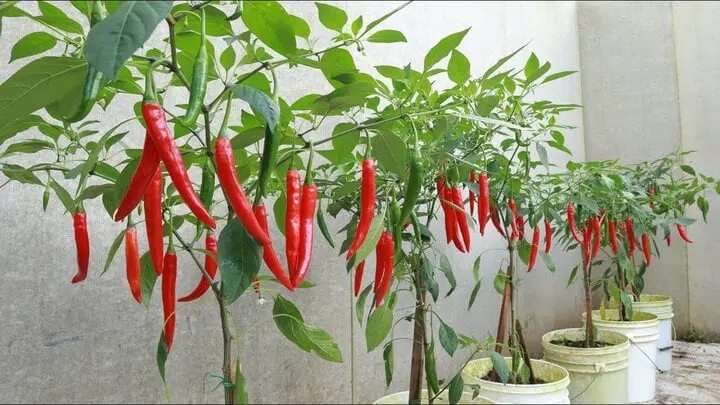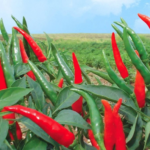Growing chili peppers is relatively easy, but to have chili plants laden with fruits, you need to master some gardening techniques, including some extremely simple tips and tricks.
A little tip to help your chilies bear fruit abundantly
This tip is to pinch the growing tip – a simple but highly effective technique to stimulate chili plants to grow more branches and bear more fruits. Pinching the growing tip helps the chili plant focus its energy on developing side branches instead of just growing taller.
Benefits of pinching the growing tip include:
– Stimulating branch growth: Pinching encourages the plant to grow more branches, increasing the photosynthetic area, and thus increasing fruit yield.
– Improving fruit quality: Chilies growing on multiple branches will receive ample sunlight, grow more evenly, and have better quality.
– Pest and disease prevention: Chili plants with well-aerated branches are easier to inspect and treat for pests and diseases, promoting healthy growth.

A little tip to help you grow chili plants with abundant fruits: Pinch the growing tip. (Image: Better Homes & Gardens)
Timing the pinch
Timing is crucial when pinching the growing tip to ensure the chili plant doesn’t weaken and has enough strength to develop new branches. Start pinching when the chili plant has grown about 6-8 true leaves (approximately 20-30cm in height). At this stage, the plant is strong enough to withstand the trimming.
How to pinch the growing tip
Use sharp scissors or a knife to cut off the main growing tip of the plant. Ensure your tool is clean to prevent the spread of diseases to the plant.
Technique: Cut off the main growing tip about 1-2cm from the tip. This encourages the plant to develop side branches from the lower leaf axils, increasing the branch area and promoting vigorous growth.
Aftercare
After pinching, maintain regular watering to ensure the plant doesn’t dry out. However, avoid overwatering, which can lead to waterlogging.
Provide organic fertilizer or NPK fertilizer to ensure the plant has sufficient nutrients to develop new branches. Regular and proper fertilization will promote vigorous growth and high yields.
Regularly inspect the plant, removing weak, wilted branches, and controlling pests and diseases promptly. Healthy chili plants are more resistant to pest and disease attacks.
Some additional tips for abundant chili fruit production
To achieve abundant chili fruit production, consider the following factors:

In addition to pinching the growing tip, there are a few other tricks to help your chili plants bear abundant fruits: Ensure adequate sunlight, use suitable soil, water properly, and provide nutrients. (Image: Pinterest)
Light and temperature
Chili plants require ample sunlight and warm temperatures to thrive. Ensure your chili plants receive at least 6-8 hours of sunlight daily. The ideal temperature range for growing chilies is 20-30°C.
Soil
Use well-drained, loose, and nutrient-rich soil for planting chilies. Before planting, enrich the soil with organic matter to provide sufficient nutrients for the plants.
Watering
Maintain regular watering but avoid waterlogging. Chili plants need moisture but do not thrive in overly wet soil. Water in the early morning or cool evening to minimize water loss through evaporation.
Fertilizer
Fertilize regularly to provide essential nutrients to the plants, especially during the flowering and fruiting stages. Use organic fertilizer or NPK fertilizer with a higher potassium content to promote flowering and fruit development.
Pest and disease control
Chili plants are susceptible to pest and disease attacks, so inspect your plants regularly for early detection and timely treatment. Use safe biological or chemical control methods to prevent and manage pests and diseases without compromising the quality of the chili fruits.
By applying these tips for abundant chili fruit production, you will notice significant differences, and your chili plants will not only meet your family’s needs but also provide enough to share with neighbors and friends.
According to VTC News
The Ultimate Guide to Growing Sweet Mustard Greens in Containers
Growing Chinese cabbage is a breeze, even for those with a less-than-green thumb. With its easy-going nature, this vegetable is the perfect choice for a home garden. So, get ready to roll up your sleeves and dive into our step-by-step guide on how to grow Chinese cabbage in a foam box. It’s time to embrace your inner gardener and enjoy the fruits of your labor, or should we say, the veggies!


































